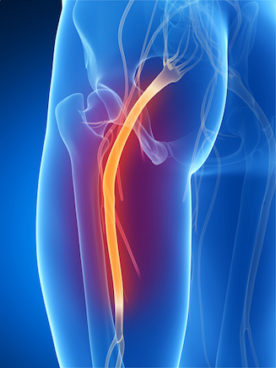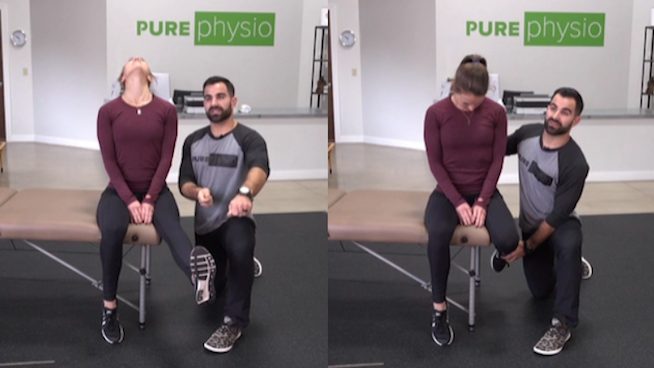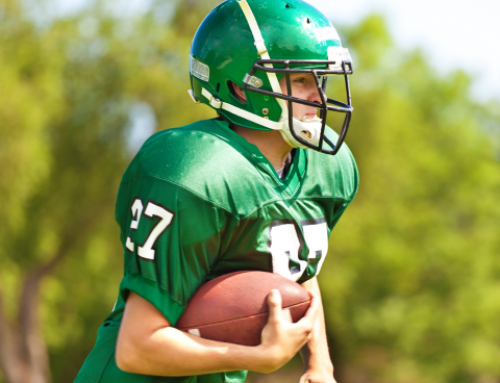The Best Sciatic Nerve Stretch Exercises to Alleviate Leg Pain
Do you suffer from chronic leg and hip pain that simply won’t go away? If so, there’s a good chance that you have sciatica, or pain that’s caused by pressure placed on the sciatic nerve.
The sciatic nerve is the largest nerve in the human body. The nerve travels from your lumbar spine (lower back) and goes through your hip and thigh all the way down to your foot. This large nerve allows your central nervous system to communicate with the structures in your hip and leg.
About 90 percent of sciatica cases are the result of a herniated disc in your lumbar spine. The disc bulges out and puts pressure on the sciatic nerve, which can cause pain, numbness or a burning sensation. The exact location of the pain depends on the location of the herniated disc.

3d rendered illustration of the sciatic nerve
Sciatic nerve pain can also be caused by Piriformis Syndrome. The piriformis is a muscle located in your hips and can compress the sciatic nerve if it spasms or is overly tight.
Regardless, it’s not a fun injury to deal with as an athlete, especially if you have severe symptoms since it can seriously impair your performance in the weight room or on the field. Or worse, it can keep you on the sidelines.
To treat sciatic nerve pain, you need a comprehensive long-term approach that addresses the cause of the problem. If it’s your lower back, we highly advise following renown spine researcher Dr. Stuart McGill’s program in his book The Back Mechanic. If a tight piriformis is the culprit, these exercises are a great starting point.
For more immediate pain relief, Dr. Matt Stevens, physical therapist and owner of Pure Physio (Strongsville, Ohio), recommends the Sciatic Nerve Glide. By extending your neck and straightening your leg and subsequently flexing your neck and bending your leg, you essentially floss your nerve back and forth in your body to help it function better within the surrounding structures.
Perform this exercise daily—or even multiple times per day—to help relieve sciatic nerve pain. However, Stevens cautions that this exercise may actually make the pain worse for some people. If that’s the case, immediately stop performing the exercise.
Sciatic Nerve Glide

How to: Sit on a chair or table with your back straight and knees bent. Slowly straighten your affected leg and extend your neck to look up. Briefly hold this position. Next, tuck your chin to your chest and bend your knee. Slowly alternate back and forth between the two positions.
Sets/Reps: 1×10-20
READ MORE:
RECOMMENDED FOR YOU
The Best Sciatic Nerve Stretch Exercises to Alleviate Leg Pain
Do you suffer from chronic leg and hip pain that simply won’t go away? If so, there’s a good chance that you have sciatica, or pain that’s caused by pressure placed on the sciatic nerve.
The sciatic nerve is the largest nerve in the human body. The nerve travels from your lumbar spine (lower back) and goes through your hip and thigh all the way down to your foot. This large nerve allows your central nervous system to communicate with the structures in your hip and leg.
About 90 percent of sciatica cases are the result of a herniated disc in your lumbar spine. The disc bulges out and puts pressure on the sciatic nerve, which can cause pain, numbness or a burning sensation. The exact location of the pain depends on the location of the herniated disc.

3d rendered illustration of the sciatic nerve
Sciatic nerve pain can also be caused by Piriformis Syndrome. The piriformis is a muscle located in your hips and can compress the sciatic nerve if it spasms or is overly tight.
Regardless, it’s not a fun injury to deal with as an athlete, especially if you have severe symptoms since it can seriously impair your performance in the weight room or on the field. Or worse, it can keep you on the sidelines.
To treat sciatic nerve pain, you need a comprehensive long-term approach that addresses the cause of the problem. If it’s your lower back, we highly advise following renown spine researcher Dr. Stuart McGill’s program in his book The Back Mechanic. If a tight piriformis is the culprit, these exercises are a great starting point.
For more immediate pain relief, Dr. Matt Stevens, physical therapist and owner of Pure Physio (Strongsville, Ohio), recommends the Sciatic Nerve Glide. By extending your neck and straightening your leg and subsequently flexing your neck and bending your leg, you essentially floss your nerve back and forth in your body to help it function better within the surrounding structures.
Perform this exercise daily—or even multiple times per day—to help relieve sciatic nerve pain. However, Stevens cautions that this exercise may actually make the pain worse for some people. If that’s the case, immediately stop performing the exercise.
Sciatic Nerve Glide

How to: Sit on a chair or table with your back straight and knees bent. Slowly straighten your affected leg and extend your neck to look up. Briefly hold this position. Next, tuck your chin to your chest and bend your knee. Slowly alternate back and forth between the two positions.
Sets/Reps: 1×10-20
READ MORE:










